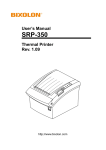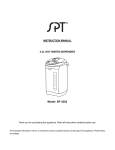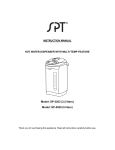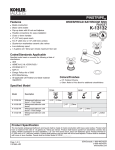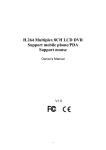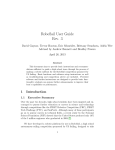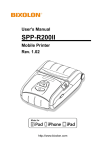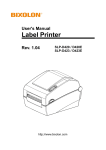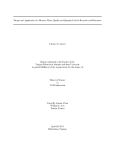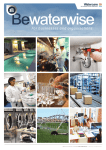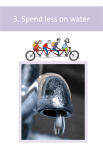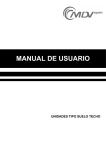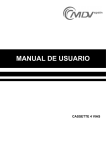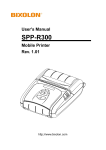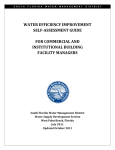Download PDF document
Transcript
3. Spend less on water Transition Streets 3.1 SPEND LESS ON WATER Water covers about 70% of the Earth’s surface; however, less than 1% of that water is available for human consumption. This small fraction must be shared globally for domestic, agricultural, industrial, and environmental needs. In the US, the average person uses about 99 gallons of water every day,[1] and national consumption appears to be growing annually.[2] In the last five years, nearly every region of the county has experienced water shortages. [2] In Fall 2014, the US Pentagon declared that Climate Change was a major threat to US National security, as rising temperature and changing precipitation patterns present a risk to food and water security. The facts If we do not take action now, climate change, population growth, and wasteful behavior will mean facing increased water stress in the future. The good news is that through awareness of how we use water, we can make decisions about how to conserve this precious resource and in doing so, create more resilient and sustainable communities. In the US approximately 60% of domestic water is used outdoors, and the other 40% inside of our homes. The key to efficiency is reducing waste, not necessarily restricting your use. You can easily reduce waste by making small behavioral changes and by choosing more water-efficient appliances. Saving water will not only help reduce environmental impacts; if you are on a water meter, it will also save you money on your water and power bills. Percent breakdown of indoor water use[3] Transition Streets 3.2 SPEND LESS ON WATER Each of these actions can significantly reduce the amount of water that your household uses. Even if you are not on a meter, it is important to conserve this most precious resource, and to consider the related carbon emissions that come from the transport, treatment, and heating of all the water that we use. So what can you do about it? Some of these actions will cost you nothing, and some will cost you a little money (but this can be offset by the reduction in your water and power bills). In your group, have a brief chat about the items, and then decide which ones you want to tackle and when. Record your own action plan on the page at the end of this section. • • • • • • • Know how much you are using (3.3) Feeling flushed (3.6) Taps, drips, & leaks (3.9) Showers & baths (3.11) Washing clothes (3.13) The kitchen sink (3.15) Outdoors (3.17) The actions listed above are the basic (but most cost-effective) things you can do in your home. At the end of the section are several other actions that you may wish to consider, once you’ve done the basics. Notes Transition Streets 3.3 KNOW HOW MUCH YOU ARE USING Cost: none $ Savings: low Effort: low CO2 saved: low Challenge As we saw in the energy section, we can’t manage something if we can’t measure it. Because they come so infrequently, relying on meter readings from your regular water bill does not give you much information about your water consumption, or if it is going up or down as a result of the actions you are taking. Also, it is difficult to determine if you have a water leak, as it will blend in to the baseline water use. Read your own water meter regularly. Just being more aware of how much water you use can have a positive impact on your household’s water wastage. It also shows you the actual results and savings from all your efforts with the other actions in this section. Solution Your water meter is likely located outside near the curb in front of your home in a concrete box labeled “water” or with a stamp of your water providers logo. In some areas, usually, in colder climates, your water meter may be located inside your home. Indoor meters are usually found in the basement. Carefully remove the lid or housing for your meter and look out for insects that may be living in the dark box. See page 3.6 for advice on reading your meter. To check for leaks, turn off all taps and water using appliances. Then check your meter. If the dial is still turning, then you likely have a leak. Yes, but ... I have no idea where my meter is. If you can’t find your meter then call your local water provider and they will be able to tell you where it is. Transition Streets 3.4 KNOW HOW MUCH YOU ARE USING Sample water meter readings log Date Water Meter Reading (cu. ft.) Usage 1/01/2015 1/08/2015 1/15/2015 1/22/2015 20,035 20,130 20,221 20,307 n/a 95 91 86 Next steps, hints, & tips • Complete the usage calculator on page 3.22 to estimate your average daily consumption. Compare it to the national average of 99 gallons (13.2 cubic feet) per person per day. • Check your meter at least monthly, particularly if your meter is located outside your property. You pay for all water that flows through the meter, even leaks. • If you’re making changes to reduce water use, try reading your meter weekly for a while, and see what difference it’s making. Use the sample water meter readings log provided above. • Keep the log visible—stick it on the fridge so everyone in the household can see it. You may consider rewarding everyone for their efforts by sharing some of the savings. • If there is more than one meter outside your house, find the meter with the number that listed on your water bill. Notes: Transition Streets 3.5 ADVICE ON READING YOUR METER There are two common types of water meters, the straight-reading meter which resembles the mileage-indicator in an automobile speedometer (see Figure 1), and the round-reading meter which has several separate dials (see Figure 2). In Figure 1, the reading is taken from the figures shown under the words “cubic feet.” The meter reads 008171, which is the total number of cubic feet of water recorded since the meter was installed. The large hand is used only for testing purposes and leak detection. Newer meters also have a small triangle that is usually red or blue, that spin when water is used. They are sensitive and can even detect small water drops that are leaking. The round meter has several small dials in a circle, and is a little more difficult to read. The dials are marked off in ten divisions, and are read much like a clock, except that the hand on every other dial turns counterclockwise. In figure 2, to check the readings, start with the “100,000” dial, and the readings are 8, 0, 6, 3, and 2 or 80,632 cubic feet. Please call your local water utility if you have any difficulties in reading the figures on your meter. Note: If you live in an older property you may have a different type of meter. Transition Streets 3.6 FEELING FLUSHED Cost: none $ Savings: med Effort: low Challenge About a quarter of all the clean, drinkable (expensive!) water we use in our homes is flushed down a toilet.[3] An old style, pre-1980s, single flush toilet can use up to 7 gallons of water in one flush. New, more waterefficient “Watersense” labeled toilets use as little as 1.3 gallons per flush.[4] New dual flush toilets use on average as little as 1.1 gallons per flush.[5] Solution If your toilet was made before 1992, consider installing a water displacement device such as a toilet dam or a an early closing toilet flapper. These devices reduce the amount of water used per flush by displacing space in the water chamber above the toilet, or reducing the amount of water released by closing the plunger faster than a traditional buoyant flapper. Note that these devices are only suitable for 3.5 gpf toilets and above. Performance can vary between toilet types. If it does not work or you want more advice, contact your local water provider. Yes, but ... Our toilet doesn’t flush well anyway, won’t this make it even worse? Don’t use a water reduction device on tanks of 3.5 or less. Try a smaller device if you need to flush twice. Remove it altogether if even the smallest one causes a problem—the idea is to reduce flushing, not increase it! CO2 saved: low Transition Streets 3.7 FEELING FLUSHED Your savings Next steps, hints, & tips By replacing old, inefficient toilets, the average family can reduce water used by toilets by 20-60%, equating to ~13,000 gallons per home every year. The savings on water use can also save more than $110 pear year![6] • Many water providers offer rebates for upgrading to more efficient toilet models. Avoiding using your toilet as a waste basket will also save money and help reduce the maintenance costs for your local waste water provider, saving you money in the long run.[10] • Use the table on the next page to identify what type of toilet you have, and what type of water displacement device you should probably be using. All toilets have a date stamp and most should have the gallons per flush labeled. • Many water providers will offer free water displacement devices for their customers. • Make your own from a large plastic bottle filled with water, or filled with sand and seal it well. • Flush less often—if it’s yellow let it mellow, if it’s brown, flush it down! This can drastically reduce usage. Notes: • Check that the water level in your tank is set correctly to the mark which will be about 25mm below the overflow. If it is just below the overflow it will be flushing about one litre more than the designed amount. • For more info visit www.epa.gov/watersense/product s/toilets or call your local water provider. Transition Streets 3.8 FEELING FLUSHED Photo Year Flush Water Consumption 1950s – 1980s Single 7.0 – 5.0 gallons 1980-1994 Single 3.5-4.5 gallons 1994- present (standard) Single 1.6 gallons 1994- present (high efficiency) Single 1.3 gallons Present Dual 1.1 gallon on average Note: All toilets are stamped with a date, which will be more helpful than trying to figure out your toilet’s age based on the photo. More information is available from the Alliance for Water Efficiency.[7] Transition Streets 3.9 TAPS, DRIPS, & LEAKS Cost: none-low $ Savings: med Effort: low CO2 saved: low Challenge Often our water bill is higher than it needs to be, and we’re not even using all of the water we’re paying for! For example, a running tap wastes over 1.7 gallons per minute. [8] Dripping taps are not just annoying, they can add up to staggering water losses if left untreated, as you can see in the table below. Dripping taps often just need a new washer, which only cost a few cents. Leaky pipes are also just dripping away your money, inside or out. Rate Gallons lost / year $ lost / year 1 drop per second 1,300 $2.60 Drops breaking to a stream 8,200 $16.40 2mm stream 146,000 $78.00 5mm stream 526,000 $280.00 Cost estimates based on approximate national average of $2/1,000 gallons.[8] Solution Check regularly for drips and leaks. To fix a dripping tap, first of all, try changing the washer. Also make sure your water pipes and external taps are insulated in time for the cold winter months. Burst water pipes can cause serious damage as well as waste a lot of water. In addition to fixing your leaks, consider old faucets with a WaterSense faucet or accessory. These devices reduce water flow rates by 30% from a standard faucet, while maintaining water pressure. Yes, but ... I changed the washer and it’s still dripping. A dripping tap usually means that the tap washer needs renewing, but it can also be caused by a damaged valve seating. If the drip is from a mixer nozzle, then change both tap washers. Transition Streets 3.10 TAPS, DRIPS, & LEAKS Your savings You can save an additional 3,000 gallons of water a year, if you turn off the tap while you brush your teeth (assuming you do this for 2 minutes twice a day). You can improve on these savings by doing the same when you wash the veggies, or rinse the dishes. Next steps, hints, & tips • Some water providers distribute free faucet aerators to their customers. • Search for a YouTube video called “Collins DIY Survival Demos - How to Fix a Dripping Tap”. • See your local hardware store. They often offer written guides or will give you specific advice. • If you’re not into DIY, contact a local plumber or handyman to do it for you. • Check your pipes regularly for visible leaks (also see section 3.4). Notes: • Use dye tabs to check if your toilet has a leak. Replacement flappers are often under $5. • Use the leftover water from your night time drinks to water houseplants. • Call your local water provider to ask about free leak detection kits and water reduction devices. • For more info visit www.epa.gov/watersens/prducts/b athroom_sink_faucets Transition Streets 3.11 SHOWERS & BATHS Cost: none-med $ Savings: med Effort: low CO2 saved: lowmedium Baths and showers make up over 16% of the average American's water use, and represent one of the most opportune areas for indoor water conservation. Challenge Baths typically use 45 gallons of water, whereas an ordinary shower uses about a half of that amount. Over a year, if you take 4 baths a week, this equates to an extra $20 worth of water (plus all the costs of heating the water).[4] Using showers most of the time, with the occasional bath, will give significant savings. The average American spends 8.2 minutes in the shower and this average is increasing. Multi-head showers are very popular and can easily use more water than a bath. While invigorating, they can more than double the water use of your shower, using more than the average person living in the developing world gets through in a day.[4] Solution Many modern showerheads are designed to reduce the water flow rate but maintain good pressure. By replacing your showerhead with a more waterefficient model, it is possible to reduce your water consumption by more than half, while still enjoying a great shower. [4] A shower timer shows how much time you have spent in the shower, and can help you save water. Yes, but ... I really do need to shower every day. Don’t take fewer showers—reduce the volume of water used and the time you spend in the shower. You can still have a great shower experience, save money on water and energy, preserve a valuable resource, and reduce your carbon emissions. Transition Streets 3.12 SHOWERS & BATHS Savings Replacing an old showerhead with a low-flow showerhead could save an average household approximately 32 gallons of water every day, and $70 per year off your water and energy bills.[8] In fact, the average family could same more than 370 kilowatt hours of electricity annually, enough to power a house for 13 days! • Next steps, hints, & tips • Buy a low-flow showerhead, which can limit the water flow to as little as 1.3 gallons a minute . Note, these are not suitable for electric showers or lowpressure gravity shower systems. • Buy an aerated showerhead, which adds air pressure to the flow. These too may not suitable for some electric or low-pressure gravity systems. • Get a shower timer to help limit your (and your teenager’s!) time. Some can tell you how much water you are using, and alerts you when you’ve had the max recommended amount. • These products are generally available online through sites such as www.biggreensmile.com. • Take a cooler shower, which also helps you to avoid temporary varicose veins . You’ll tend to get out of there quicker too. • Save the cold water that runs while waiting for the hot—keep a bucket or watering can handy then water the plants or use it to flush the toilet once you’re finished. • If you do have a bath, you can siphon out your bath water and use it to water your garden or flush your toilet. • For more info, call your local water provider or visit http://www.epa.gov/WaterSense/products/showerheads.html Notes: Transition Streets 3.13 WASHING CLOTHES Cost: none $ Savings: lowmed Effort: low CO2 saved: low Challenge The average water consumption of washing machines is about 31-45 gallons per wash—although modern machines use less than older models, it’s still quite a bit of water. Washing clothes accounts for about 22% of the water that we use in our homes, so by reducing wastage in this area we can make significant water savings—the average family does almost 400 loads a year. [3,4,9] Solution Washing machines vary tremendously in how much water they use per wash. Older models can use as much as 56 gallons per load, where the modern high efficiency models average closer to 14.4 gallons per load.[4] For households that do many small loads of laundry, there are smaller machines that are even more water efficient. When using your washing machine make sure you know about the different cycles—many have a half load or eco load option. Take a look at the manual which should tell you how much water (and energy) the different options use. If you plan to buy a new one, make sure that it’s water efficient. Washing at a lower temperature doesn’t save water, but it will save on your water heating costs. Many powders and liquids are designed to work at lower temperatures, and they work well. Yes, but ... I have to keep up with the washing, or else it becomes a mountain in this house! Consider how often you really need to wash your clothes. After every wear? We often wash things that don’t need it out of habit—if it doesn’t look dirty or smell too bad, it may last another day. Transition Streets 3.14 WASHING CLOTHES Next steps, hints, & tips • When replacing your old washing machine, make sure to buy a water efficient model. See product comparisons at www.energystar.gov/products/. Also, check with your local water provider for information on potential rebates. • More expensive models that use less water will generally still save you money in the long run. • When using your washing machine, make sure to use a full load every time. Surveys have shown that a typical load of laundry is usually much less than the maximum capacity of the model. • If you really need to do a wash but don't have a full load, use the half load feature. However some half loads will use almost as much water as a full load – so two half loads will use more water and energy than one full load. • If you're purchasing a new machine, choose a model with a capacity that is appropriate for your situation. If you live alone, consider a smaller, apartment sized model. • Familiarize yourself with your washing machine’s cycle options. Some settings provide the same cleaning power but with less water and energy. Check your user manual or contact the manufacturer. • Avoid pre-washing. Most modern washing machines and washing powders are so effective that you don’t have to pre-rinse. • Use the “High-Efficiency” (HE) detergents with the modern front loading machines. They are specifically designed to keep dirt and grime suspended in lower volumes of water. • For a great explanation about different machine types, visit http://www.allianceforwaterefficiency.org/Residential_Clothes_Washer_Intro duction.aspx Notes: Transition Streets 3.15 THE KITCHEN SINK Cost: none-low $ Savings: lowmed Effort: low CO2 saved: low Challenge The kitchen tap and dishwasher account for about 16% of water used in the home, so there’s a huge opportunity here to reduce water wastage. [3] Kitchen taps vary tremendously in flow volume, and behaviors such as how much you twist the tap and for how long you leave it turned on influence how much water is used when you wash up. Photo via flickr by Steve Johnson. Licensed under Creative Commons https://creativecommons.org/licenses/by/2.0/legalcode Washing up or rinsing dishes under a running tap can use dozens of gallons of water, but if you use a washing-up bowl or plug your sink, you can dramatically reduce water wastage. Solution A common misconception is that dishwashers use more water. In fact, these machines can be water savers—if used wisely. In the 1980s, dishwashers used as much as 14 gallons per cycle, but modern models can use as little as 4 gallons—sometimes even less than washing up by hand.[4] If you are thinking about buying a new dishwasher, you can refer to the rankings on www.energystar.gov/products/ for guidance on which models are the most water efficient. Yes, but ... sometimes I have to wait for ages for hot water to arrive at the tap, which wastes lots of cold water down the sink. Collect all the waste cold water in a watering can that you leave by the sink, then use it on the garden or your houseplants. Transition Streets 3.16 THE KITCHEN SINK Next steps, hints, & tips • Consider installing a more water-efficient tap, or a tap aerator. Aerators in particular are cheap and simple quick fixes that you can do yourself. • When washing up by hand, either use a washing-up bowl or plug your sink. Then you can use what’s left over to water your houseplants. • Try to avoid thawing frozen foods under running water. • Keep a jug of water in the fridge so that you don’t have to run the tap for ages while waiting for cold water to flow. • Consider composing your food waste instead of using your garbage disposal unit in your sink, they require lots of water to operate properly. • When using your dishwasher, make sure to use a full load every time. Two half loads still use more water and energy than one full load. • Become familiar with your dishwasher’s cycle options for lower temperature/duration cycles. Check your user manual or contact the manufacturer. • Most modern dishwashers are so effective that you don't ever have to prerinse. • Use the minimum amount of water required when you boil water in saucepans and kettles—you'll save energy as well as water. • For more info visit www.energystar.gov/products or http://www.allianceforwaterefficiency.org Transition Streets 3.17 OUTDOORS Cost: low-med $ Savings: medhigh Effort: low CO2 saved: lowmedium Challenge Outdoor water use accounts for around 60 percent of the total water use, but this number varies drastically across the country. [3] Many of us still use water that has been treated to drinking-quality to irrigate thirsty lawns and gardens. Improving our outdoor water use efficiency is one of the best ways we can improve our resiliency to times of drought and water scarcity. Photos above from flickr. Sprinkler by Robert Couse-Baker and rain barrel by Metropolitan Planning Council. Licensed under Creative Commons https://creativecommons.org/licenses/by/2.0/ When planning your landscaping, consider using native or horticultural varieties of native plants. These plants are typically better suited for the local weather patterns, and provide excellent micro-habitat for native insect and bird species. Solution By using water-efficient gardening practices like drip irrigation, mulching, and soil moisture sensors, you can still have a beautiful, living garden even in times of extreme drought. Try to avoid using tap water to water the garden. Instead, collect rainwater in a rain barrel (rainwater is also better for your plants) and/or consider reusing water, or grey water, on the garden. See reference section at end for more info on grey water and on rainwater harvesting systems. Yes, but ... I can’t use my old bath water for the garden due to the bath soap. Biodegradable soaps are now widely available. These soaps use compounds that easily break down over time in the soil. Transition Streets 3.18 OUTDOORS Next steps, hints, & tips • Your hose uses as much as 23 gallons of water per minute. [4] Placing a nozzle on your hose can reduce the water output to under gallon a minute by cutting the waste between watering areas and allowing you to use water where and when you really need it. • Use a watering can for watering potted plants and small raised beds. • Giving your plants' roots a good soaking once or twice a week in dry weather is much better than lightly watering them every day. Water should be directed underneath the foliage. There should be enough to wet the top few inches of soil, where most plants’ roots are. • Don’t over water — there is no need for hanging baskets and containers to drip after watering. Many plants can still do well when watered little, but daily. Over watering may also weaken plants. • Sprinklers can use as much as 260 gallons of water per hour! If you really must, use it early in the morning or late in the evening. • Mulching soil around your plants will not only keep away water-loving weeds, but will also keep the soil cool and decrease evaporation. • Invest in a rain barrel. Every 1,000 square feet of roof area collects about 600 gallons of water for every inch of rainfall. This free source of water can be used during dry periods between storms and can significantly reduce your use of fresh potable water. • Grey water systems are a great way to reuse sink and shower water to irrigate your landscape instead of using fresh drinking water (see section 3.24 for more info). When using grey water, be cautious that you do not treat grey water as an excuse to be lax with indoor water use. • Rather than washing your car with a running hose, try using a bucket and sponge instead (ideally fill the bucket from the rain barrel). • For more information on Rainwater Harvesting and drought resilient landscaping, see Brad Lancaster’s series at www.harvestingrainwater.com • For more information on plants that are native to your area, check out your local Native Plant Society. Transition Streets 3.19 YOUR WATER ACTION PLAN Possible actions: Reminder • Know how much you are using • Showers & Baths (3.11) (3.3) Washing clothes (3.13) • Feeling flushed (3.6) The kitchen sink (3.15) • Taps, drips, & leaks (3.9) Outdoors (3.17) What other ideas does your team have that aren’t covered above? Add them below if you think they are relevant for you... My actions Already done When I’ll do this Notes Group actions How can you help each other out in your team? List team actions here (with named person and due date): Transition Streets 3.20 WATER: THE BIGGER PICTURE DISCUSSION Each American uses about 99 gallons of tap water a day, but if you include the amount of water embedded within products, our water consumption is actually around 2,000 gallons every day. About 20 percent of the embedded water that we consume comes from other nations, as we import goods and services into our country. (13) Questions for discussion About two-thirds of the water that we consume is embedded in our food. For example, a pound of tomatoes have about 14 gallons of water embedded in them; apples about 83 gallons; tofu about 240 gallons; pork about 570 gallons ; and beef about 1,800 gallons. (14) If present levels of consumption continue, two-thirds of the global population will live in areas of water stress by 2025. Over the last decade, extreme weather events such as heat waves, floods, and droughts occurring at greater frequencies. Though many parts of our country are as lush and rainy, those regions are not immune from water scarcity problems. We, too, can run out of water. • What do you think is an acceptable level of water consumption (gallons per person per day)? • Besides water efficiency, what else can we do to reduce our overall water consumption? • Do you feel you have enough information to make informed choices about the water impacts of what you buy, from t-shirts to hamburgers? (See section 3.26 for more.) • Should the government insist that all households are metered to help ensure we take water efficiency more seriously? Notes: Transition Streets 3.21 QUICK USAGE ESTIMATER You and your group can use this quick and easy water use estimator to give you an idea about how much water your house uses every week. More thorough calculators are also available online. Wecalc.org offers a very in depth evaluation of your households water use based on behavior, appliances used in your home, and the age of your homes appliance. The final screen lets you know not only how much water you use, but provides targeted recommendations and estimates your carbon foot print from the water you consume. Transition Streets 3.22 REFERENCE INFO References [1] USGS. “Domestic water withdrawals and deliveries,” 2005, http://water.usgs.gov/edu/wateruse/pdf/wudomestic-2005.pdf [2] U.S. Environmental Protection Agency, “WaterSense,” 2008, http://www.epa.gov/WaterSense/pubs/supply.html [3] Aquacraft, “Residential End Uses of Water,” 1999, http://listserver.energy.ca.gov/appliances/2013rulemaking/documents/responses/Water_Appliances _12-AAER-2C/California_IOU_Response_to_CEC_Invitation_to_ParticipateToilets_and_Urinals_REFERENCES/Aquacraft_1999_Residential_End_Uses_of_Water_Study.pdf [4] WECalc, 2014, http://wecalc.org/WECalc_data_and_assumptions.pdf [5] Alliance for Water Efficiency, “Toilet Retrofit Devices Introduction,” http://www.allianceforwaterefficiency.org/Toilet_Retrofit_Devices.aspx [6] U.S. Environmental Protection Agency, “Water-Efficient Toilets,” http://www.epa.gov/WaterSense/products/toilets.html [7] Alliance for Water Efficiency, “Frugal Flushing,” http://www.home-water-works.org/indooruse/toilets [8] U.S. Environmental Protection Agency, “Drinking Water Costs and Federal Funding,” http://water.epa.gov/lawsregs/guidance/sdwa/upload/2009_08_28_sdwa_fs_30ann_dwsrf_web.pdf [8] U.S. Environmental Protection Agency, “Water-Efficient Showerheads,” http://www.epa.gov/WaterSense/products/showerheads.html [9] U.S. Environmental Protection Agency, “Green Building: Laundry Room & Basement,” http://www.epa.gov/greenhomes/Basement.htm [10] Mekonnen, M.M. and Hoekstra, A.Y., 2010, The green, blue and grey water footprint of farm animals and animal products, Value of Water Research Report Series No.48, UNESCO-IHE. [11] Hoekstra, 2008, “The water footprint of food,” http://www.waterfootprint.org/Reports/Hoekstra2008-WaterfootprintFood.pdf The following pages are for reference information only, and don’t need to be discussed at the water session. Transition Streets 3.23 OTHER WATER-SAVING OPTIONS Overview and where to go for more information Rainwater harvesting Rainwater harvesting is a great way to reduce your overall water use wherever you live in the country. Rainwater is ideal for ornamental landscaping as well as edible gardens (though it may be questionable for use with root vegetables). When managed properly, rainwater harvesting can also help reduce urban runoff from your property. Designs range from sophisticated systems with large underground tanks with pumps, storing thousands of gallons, to smaller-scale DIY systems that simply gravity feed rainwater from large wall mounted barrels through the outside wall to a toilet tank. The garden rain barrel is the simplest way of collecting rainwater. It does not need any treatment or mains backup, and it does not have to supply water when temperatures are below freezing. Be sure you check your local plumbing code before installing a system, as many states prohibit capturing runoff at home. The website www.harvestingrainwater.com has links to helpful information online and some of the best literature on rainwater harvesting and other ways to make your outdoor environment more drought tolerant. Greywater reuse systems Grey water refers to all household wastewater other than wastewater from the toilet (blackwater). Grey water from baths, showers, and laundry is less contaminated than that from the kitchen. The most basic systems simply divert cooled and untreated water to irrigate the garden. More advanced systems treat water for re-use in toilets. It is important that all grey water systems be free of bleach, dyes, salts, cleansers, or shampoos and soaps containing nonbiodegradable compounds. The website greywateraction.org offers a comprehensive look at grey water including plumbing codes, system designs, and best maintenance practices. Transition Streets 3.24 REDUCING YOUR WATER FOOTPRINT The World Wildlife Fund (WWF) and other experts believe that it’s essential to break the link between economic growth and higher water usage. They suggest that agricultural practices like rainwater harvesting for irrigation are one way. We could also cut consumption patterns that require ever more water, e.g., buy less ‘water-heavy’ goods, often grown miles away from us in countries that have water shortages, like cotton from Pakistan. See the table below for some hidden water costs in our food.[11] A verage Water Use in Gallons/Pound Apple or pear 83 Banana 102 Beef 1,832 Cabbage 24 Cheese 591 Chicken 461 Coffee 17 Cucumber or pumpkin 28 Dates 355 Groundnuts (in shell) 366 Lettuce 15 Maize 106 Mango 189 Oliv es 520 Orange 54 Peach or nectarine 142 Pork 567 Potato 30 Rice 402 Sugar (from sugar cane) 4 Tomato 14 Values calculated from Hoekstra. 2008. Food Water footprints “Controversially, as water becomes scarcer, some countries may have to give up growing certain crops and rearing animals. When the water needed to grow crops has to be pumped hundreds of metres from below, the true cost of food on supermarket shelves becomes clearer.” wrote journalist John Vidal, The Guardian 29.09.06. For more info visit http://www.waterfootprint.org/?page=files/Animalproducts

























